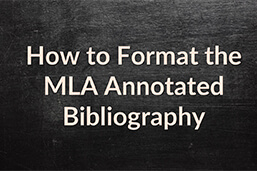
The MLA citation style proposes several guidelines for correctly citing research sources in a research publication. Students use the MLA annotated bibliography to highlight their sources in the order used throughout the body of the research paper.
Definition: MLA Annotated Bibliography
The MLA annotated bibliography refers to the section of an MLA formatted paper that lists the citations used in a research document. The citations also include a summary paragraph known as the annotation. The MLA annotated bibliography is included after a research paper to draw the readers’ attention to the relevance and quality of the sources.
Creating the Citations for MLA Annotated Bibliography
There are various types of sources that can be cited in the MLA annotated bibliography section. The following guidelines show how to mention some of them:
MLA Bibliography Citation – Website
The MLA bibliography citation is similar to the Works Cited section. To cite a website as a source in the MLA annotated bibliography section, begin by following the usual MLA citation style, which includes:
- The name of the author
- The name of the page or article
- Title of the website
- Version number
- Date of access
To write the annotation, skip two lines after your bibliographic citation and write your annotation as a paragraph. Make sure you indent the paragraph throughout the annotation.
MLA Bibliography Citation – Book
The MLA format gives the following rules for citing books in the MLA annotated bibliography style:
- Cite the author and the title of the book.
- If there are several authors in a single book, always cite the specific author of the section you have cited.
- Also, note the appropriate commas and punctuation marks to mark the various elements of the citation.
MLA Bibliography Citation – Scientific Journal
Journals often have volumes and issue numbers. When citing scientific journals, follow the structural rules as follows:
- Write the title of the article in title case.
- Write the name of the journal in italics.
- Add the volume number and then a period.
- Enter the year of the publication in parentheses.
- Include the page number before you write the annotation.
Writing the Annotations for MLA Annotated Bibliography
The MLA style stipulates some directions for writing the annotation elements in the annotated bibliography. You can use precise phrases in place of grammatically correct sentences. You can mention main points without conjunctions and other grammatical aids if you adhere to concise structure. If there are no specific instructions given, aim for one paragraph.
MLA annotated bibliography sources can be descriptive or evaluative. The main aim of the bibliography is to talk about the source in broad terms. Therefore, you should avoid talking about minor details. Always refer to your research instructions to create an MLA annotated bibliography.
MLA Annotated Bibliography Formatting
Always list your sources in an MLA annotated bibliography in alphabetical order. However, depending on the nature of the assignment, they can be listed in chronological order. The annotation should be indented an inch from the left margin, while the hanging indent of the sources is indented at 0.5 inches. Where the annotation is one paragraph, stick to one indent. Annotations that exceed one paragraph have their first lines indented for each paragraph.
MLA Annotated Bibliography Formatting Checklist
The formatting requirements of the MLA annotated bibliography include:
- Cite sources in alphabetical order.
- Use double spaces.
- Align your paragraph to the left.
- Use a hanging indent of 0.5.
FAQs
Not always. In some cases, the MLA format may have a ‘Works Cited’ section in place of an annotated bibliography.
The works cited section and the annotated bibliography both list sources of research. However, short paragraphs or annotations describe citations in annotated bibliographies.
The primary sources of research are mentioned in the annotated bibliography. These include journals, books, and websites.
The annotation should be one paragraph long. Although in some cases, you may add more sections depending on the instructions given.
Evaluation is the process of judging or inferring critical points from an experience. Reflection is the recollection of past events.
